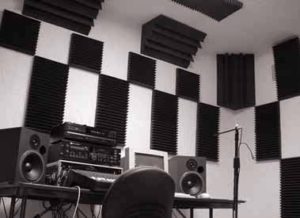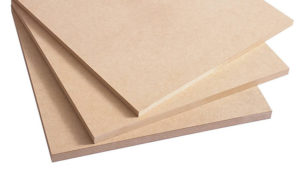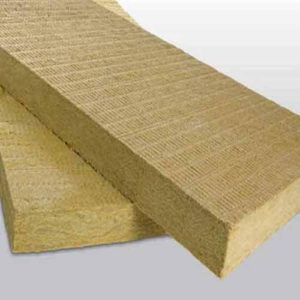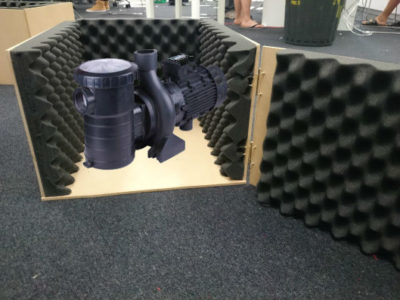-
Is soundproofing important? Well, if you live in a house that has a water pump or you are in your little cabin in the woods, you will notice the discomforting noise produced by the water pump. Water pumps also are used in RV’s, campers, boats, and other places. If you are like me, you won’t like that disturbing noise and will do what it takes to get rid of it. (you probably came here for a solution, and that’s what you will get!)
The three main ways you can reduce the sound levels are obvious:
- Distance: Sound waves won’t travel forever. They lose energy with every inch traveled. So if you are far from your wife, you will notice that you can’t hear her very well (that’s a good thing, so keep the distance or soundproof your wife)
- Noise Cancellation devices: Although this subject deserves another article to go more in-depth about the phenomenon you may have noticed on Amazon, noise cancellation headphones produce out of phase waves that cancel with external ones. (not the case here, if you don’t want to wear headphones all the time)
Reflecting or absorbing the noise using special materials designed for soundproofing – This is what we will
 use for
use for- soundproofing a water pump. If you think about sound as a rubber ball you may better understand the effect.
- Throwing the ball on a concrete floor will make the ball bounce several times while throwing it on a bed will lead to almost all energy being absorbed. That’s valid for sound waves too.
- The basic soundproofing materials have a conic shape to reflect the sound combined with the material to absorb it. Notice how a recording studio walls are decorated.
If you don’t want the theory behind it, skip ahead to the actual soundproofing materials and steps you will need to follow. It is important to be aware of the information below. But if you are a more tech person, and you can handle stuff on the fly, skip this.
To soundproof a water pump, we need to put it into a box and apply some soundproofing materials between the pump and the box. The material’s characteristics will be presented in depth. You may also isolate a part of the pipes that come out of the pump for extra soundproofing.
Things to check first
First of all, make sure you check these prerequisites in order to be sure we are not working in vain:
- Make sure the noise is not caused by a leak either in the toilet, tap, or other pipes. I know a case with a toilet leak that made the pump refill the toilet tank every five minutes. The water pump started more than 10 times in an hour for nothing. So please check the pipes, taps, toilets, and shower for any leaks that could cause the pump to start.
- Install your water pump correctly following the manufacturer’s instructions.
- Again the leak problem, another case was with a tap that hasn’t been tightened properly causing the pump to start.
- Normal flow of water – make sure the pump has enough water, and there are no problems with the water supply network. Irregular water flow will cause problems, and the water pump will give birth to odd noises
- Random activation of the pump – multiple causes presented above, make sure the water pump is running only when needed, otherwise, it can suggest that there is a problem.
Maybe an easy fix: Several water pumps are specially designed to offer quiet operation. They can be more expensive though, and, even with these special pumps, you may need additional soundproofing if the pump is not installed in the basement. If you use an old pump that it’s “almost done,” you may consider getting a new one. Old pumps are typically louder, and the age takes its toll.
Why does water pump produce noises?
A water pump produces sound waves in two ways: airborne noise (sound waves transmitted through the air) and vibration (the sound created by materials vibration). Both of them are wrecking my head so we will see how we can greatly reduce them.
The airborne sound energy (airborne sound) encountering in its direction of propagation of a dividing membrane that delimits two environments (eg. a wall) is divided into three parts:
- a part of the sound that is reflected
- a part of the sound which is absorbed in the surface and inside the material from which the dividing member is made
- a part of the sound that is transmitted to the other side of the divider caused by its vibration
The sound spreads through the air but also through solid and liquid bodies through vibrations. To prevent sound propagation, it is necessary to put elastic materials that receive (and absorb) the vibrations between the source and the destination.
The elastic materials receive the vibrations but do not transmit them further. Instead, they amortize the sound by absorbing it. This is achieved either with elastic materials (rubber, plastics, etc.) or with porous materials. These materials also prevent the reflection of sound waves back into the environment.
The sound energy of impact (the sound of striking) is transmitted inside the divider element by solid conduction and then radiated to its opposite surface in ambient air in the form of airborne sound energy.
Typically, airborne noise is transmitted through vertical splitting elements (in English: walls). On the other hand, horizontal splitting elements (in English: floors) are “good” at transmitting sound waves through vibrations or mechanical shocks.
SOUNDPROOFING WATER PUMPS
Here is the meat of this article and the reason you arrived here. After this part, there is a step by step guide and materials you will need.
Let’s dive in:
 One solution is to mount the water pump on a concrete square block as that would be heavy enough to dampen the vibrations and reduce the noise.
One solution is to mount the water pump on a concrete square block as that would be heavy enough to dampen the vibrations and reduce the noise.- You could also make a box to cover it up. It must be made of something dense like thick chipboard but make a removable hatch in the top of it to give access to the pump.
- It’s also possible that the noise is being transmitted by its pipework. If this is the case, it might be possible to fit a flexible pipe on the pump outlet.
Another solution is to have a submersible water pump in an aqua tank. This way the pump will sit inside the water tank and comes as a sealed unit. The submersible pump produces very little noise.
Reduce vibration noise
The water pumps should be placed together with their engines in a separate enclosure. In order to prevent and reduce the shocks caused by the water pump engine, this needs to be placed (together with the rest of the pump) on a massive concrete block which is placed on its own on a vibration-damping layer (expanded cork, rubber, etc.), mounted continuously.
The base of the engine shouldn’t be connected in any way to the foundation of the building on the sides. If this connection is really needed, it must be made using elastic materials (Figures 67a, b). The connection between the pump and intake and drainage pipes is performed by means of a screwdriver flange with high pressure with metal inserts or with a metal bellows (Figure 68).
Reduce airborne noise
In order to combat the airborne noise caused by the water pump, it is necessary to cover the interior walls and ceilings of the rooms with sound-absorbing materials such as porous fiberboard and install heavy and tight access doors.
You can use acoustic foam to cover the internal walls for extra soundproofing. You can get it pretty cheap from your local home improvement store or from Amazon. You can see that there are different types of acoustic foam, but the most expensive is probably not worth the price.
Usually, the expensive acoustic foam is heavier and made of better materials, but it’s a huge difference and probably the basic/cheaper ones will be fine for your project. If you have some money to spend, you can go for the expensive stuff because it is indeed better.
The ventilation ducts provided for the natural ventilation of the enclosure should be sealed with noise-absorbing materials. Pipes through the walls or floors are carefully sealed with elastic materials (mineral wool, porous fiberboard, etc.). The exhaust vent holes will be 4-5 cm in diameter larger than the pipe diameter.
Steps to build the water pump box:
- Get thick soundproofing panels. Make sure you compare them or see my suggestions page – Noise Reduction Rating (NRC) value is used to compare these types of materials: acoustical panels, MLV (Mass Loaded Vinyl).
- Nails or screws or glue
- Soundproofing materials like rock wool, mineral wool, fiberglass, etc. -> This will be placed inside the box.
- If you want to go even further, you can put the first box into a bigger one and apply some rock wool/mineral wool between the two boxes. Be sure to connect the boxes using rubber and not a material that is a good sound transmitter.
- Cut the panels to fit the length, width, and height of the water pump.
- Cut the holes for the pipes.
- Use 3m adhesive spray or a strong double-sided tape to glue the soundproofing materials (or check my suggestions page).
- Final assembly: use the nails, screws, PVA glue, hide glue, or epoxy to seal the box. If you use glue, you can use clamps or press the surfaces for a few minutes. As they are big surfaces, you can put them easily in a position that will let the glue dry.
With the box done, it’s time to put the water pump inside (you should leave one side open). Now, pay attention to these important tips:
TIP No. 1: Always install your water pump box on top of a thick concrete box.
TIP No. 2: Place a thick rug or anti-vibration pad under the concrete box.
PHYSICAL-MECHANICAL CHARACTERISTICS
Thermal and acoustic insulation materials used in construction are characterized by a series of physical and mechanical properties. The actual effectiveness of their use in construction depends on the type of project. The more important physical characteristics of the materials are the thermal and acoustic characteristics, meaning: how good are they at insulation and soundproofing.
FUNCTIONAL CHARACTERISTICS
Sound absorption is the ability of materials to reduce vibrations (noise or sound) that are received on their surface.
The tougher and porous the material is, the higher the sound absorption. That’s what we need to use here. Sound absorption is dependent on the thickness of the material and the sound absorption values.
MATERIALS USED
The first category is cohesive fibrous materials. The name is pretty complex but these materials include:
Fibrous plates or fiberboard
These are obtained by mechanical or semi-chemical defibration of wood or vegetal products (reed, straw, pepper, etc.) and by sticking and sealing of fibers with lignin activated with synthetic resins. To withstand the action of microorganisms and fire, fiberboards are treated in their mass with fungicides and flame retardants.
- Get thick soundproofing panels. Make sure you compare them or see my suggestions page – Noise Reduction Rating (NRC) value is used to compare these types of materials: acoustical panels, MLV (Mass Loaded Vinyl).

Fiberboards
Fiberboards are divided according to their apparent weight in two main categories: insulating boards and hard boards. Fiberboards can be cut with regular carpentry tools.
Fibrous materials
The most commonly used fibrous material in construction is mineral wool.
Mineral wool
This is made up of very thin, glassy, impregnated and threaded fibers. It is obtained by steam blowing at a pressure of 6-8 atmospheres of an acidic metallurgical slag melt or siliceous mineral rocks.
Mineral wool is fire-resistant and won’t be attacked by rodents and microorganisms. It gets squeezed/pressed over time and has high resistance to water absorption. The maximum use temperature is 600 degrees Celsius, so it can be used in most applications without problems.
Mineral wool can be used as thermal insulation for walls or industrial equipment and thermal pipes as well as for soundproofing walls. It is used in acoustic treatments too because it’s a good sound-absorbing material.

Mineral wool
Materials List:
- Concrete block
- MLV or fiberboard
- 3M spray adhesive
- PVA glue, hide glue, or epoxy
- Weather-stripping tape
- Anti-vibration pad
- Rock wool /mineral wool
For room soundproofing materials, please see the suggestions page for this post.
Water pump and box maintenance
The first time you install the box, check the temperature inside to see it doesn’t go too high. Some water pumps can produce a lot of heat, and the box keeps it inside very well.
Also, make sure you do regular maintenance of the pump especially if the noise level increases. Some water pump parts need lubrication. Check all parts to see they are tightened well and replace old parts if they are broken or loose.
Conclusion
If you don’t want your water pump to sound like in the video below, you may want to soundproof it. Soundproofing a water pump is usually an afternoon project, and it shouldn’t take too long if you have all the materials and tools. First, make sure that the water pump is installed correctly. The most important thing to avoid is the contact surface between the wall and the water pump or the water pump box. Also, follow the advice and install it in the basement. Following these simple tips, you can enjoy a quiet and peaceful place.
